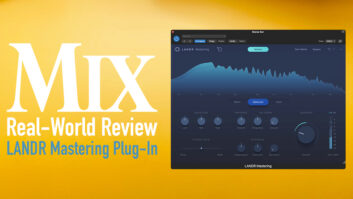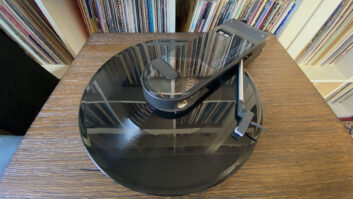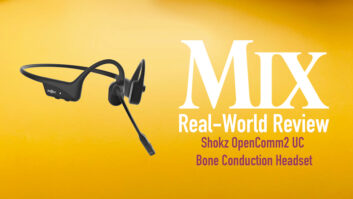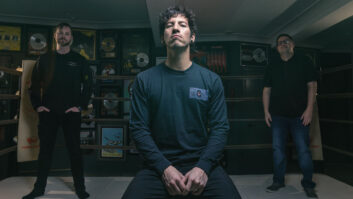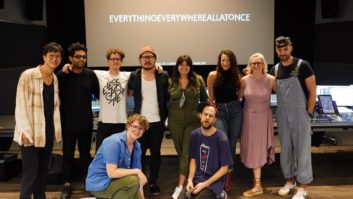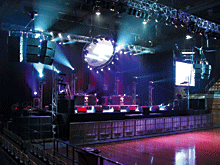

The scariest P.A. is the one you’ve never met before. Traveling with production is a very comfortable place: You always know what type of gear you’ll be using, you know it will be set up correctly and you learn to adapt to any operational quirks you’ll discover. When you bring the same system into different venues, it quickly becomes apparent what the P.A. contributes to the sound vs. what the venue contributes.
However, when fall rolls around, many bands return to smaller venues such as clubs and theaters. Smaller venues usually mean less revenue, which translates into “it’s too expensive for us to carry production so we’ll use promoter-provided gear.” Mixing on someone else’s P.A. is a completely different animal from carrying your own. Here are some ideas to help you make the adjustment and maintain some level of sanity.
GETTING TO KNOW YOU
When advancing a show, start by speaking with the proper person. Club management may lose your latest P.A. rider, input list and stage plot, and then go into their files and pull paperwork that someone sent to them via courier pigeon in 1975. Speak to the house engineer and e-mail or fax your info directly to that person. Tread carefully if you’re told, “I won’t be here but Bob will, and he’s mixed everyone from the Moses tour to Britney.” I find it diffficult to advance with someone who won’t be at the venue on show day because miscommunication inevitably leads to a finger-pointing match over what was promised.
Get a list of gear (often posted on the venue’s Website) and venue capacity. Every once in a while, I shudder at what I think will be a lack of power or speaker coverage, only to breathe a sigh of relief when I learn that the room only holds 500 people. Always ask where the mix position is located. I remember one place in New Jersey where I was expected to mix front of house from the side of the room, behind the P.A., where monitor land would normally be located. Sorry, I didn’t do that for bar bands in Brooklyn, and I’m certainly not going to do it with Blue Öyster Cult. That’s why they call it front of house. If the venue rents P.A., you might have a say regarding location of the mix position, but that’s a sticky situation because the venue is usually reluctant to give up seats. Ask the house engineer if there are any quirks to the mix position, especially when it’s located in a balcony or booth. You might learn that you are mixing within a bass trap. Part of your soundcheck should include walking the room to evaluate the coverage. You may not be able to solve all coverage issues, but if there are front-fills, then you can adjust their aim to make the folks down front happy.
Unfortunately, any advance must include some silly questions. One of my favorites addresses the number of compressors and gates available at the house console. Many smaller venues use multi-dynamic processors such as the dbx 1066 2-channel gate/compressor or PreSonus ACP88, which provides eight channels of gating/compression. This approach is different from eight channels of gate and eight channels of compression because you don’t have the ability to separate the gate from the compressor and patch them to different channels. Some folks will count the ACP88 as eight gates and eight comps, which it is not. (Note: I’m not picking on PreSonus; I’m picking on people who don’t know how to count). You need to know ahead of time whether the requisite number of processors will be available so you can request additional gear or bring it along with you. A note on carrying your own processing rack: You’ll need two sets of wiring harnesses: one with “insert”-style cables (TRS-to-dual-TS breakout) and another with “normal” TS (or TRS) cables for consoles that use separate jacks for insert send and return. Other dumb but necessary questions include: How many channels on the desk have mic inputs? How many actually work? What is the number of snake channels from stage to FOH? If you don’t ask, don’t be surprised by the reality you encounter.
WHAT YOU NEED TO PACK
If you can’t have all of your toys, all of the time, then you may be able to travel with key elements. Traveling with the lead singer’s mic and a “money channel” can cut down on wasted time and energy. Ditto for your effects, particularly if you use a lot of specific delays or ‘verbs for specific songs. This can ease a lot of stress when you have to “grab it and growl” and don’t have time for programming. (Armed with the appropriate memory card, you can program a device such as the Yamaha SPX-990 at home, store programs on the card and take it with you.)
Speaking of programming, you’ll need to become familiar with a variety of effects units. On a daily basis, you can expect to see any of the following: TC Electronic M•One and D•Two, Yamaha SPX-990/900/90, Roland SDE-1000/3000/330, Lexicon PCM70/80/81/90/91, and Eventide H3000 and Eclipse. Learning how to quickly program these devices is a mandatory skill. Some of the less-common effects devices you’ll encounter include Lexicon Model 300, TC Electronic M5000/M3000/M2000 and Klark Teknik DN780. Download the manuals and make it your business to learn them, or at least maintain a library of PDF manuals on your laptop. One of the joys — or horrors, depending on your perspective — of P.A. du jour is that you get to use different gear all of the time, so you sharpen your tech chops really quickly. If new consoles scare you, then attend a demo or workshop for desks such as the Digidesign VENUE, DiGiCo D5 or Yamaha PM5D — and don’t forget that software is available to help you preconfigure these desks, so you can load in scenes when you arrive.
USE YOUR EARS
A CD with familiar music and/or test tones can help reveal technical issues in an unfamiliar P.A. Listen to the system for left/right consistency, overall volume capability, coverage, phase relationships between driver and cabinets, and unwanted noises such as rattling grille work or blown drivers. Get into a routine of using signals that help you understand the nature of a P.A. You may not be able to run spectrum analysis, but playing third-octave tones can help identify nonlinearities so you can adjust accordingly. Though I’m not shy about adjusting the output levels of a crossover or drive processor, check with the house engineer before you modify a crossover frequency setting. Sometimes these adjustments are best left alone or left for someone who knows the system more intimately.
I DON’T WANT TO SHARE
Dealing with opening acts becomes a big issue at small venues. Carrying your own mics is a wonderful thing because, as my friend Bruce Swedien once pointed out, “you know where they’ve been.” Nothing compounds an unfamiliar P.A. system more than unfamiliar mics, and having your own means that opening acts need not share, which facilitates changeover between acts. Often, there are not enough channels on the monitor and/or house desks to avoid sharing between bands. If possible, set aside any extra channels for the opener’s drums because that’s where engineers apply different EQ and gain settings.
Sharing channels on a monitor desk is another story. In my book, that story starts and ends with “no.” It’s simply too time-consuming to change monitor settings from act to act unless the monitor console is programmable. If you don’t have the ability to program a scene, then you’ll need to split the channels between opening and headlining acts. Concessions must be made on both parts, so have an idea ahead of time about which channels you can nix from monitors. Likely candidates include the snare bottom, overheads and bass mic (assuming there’s a DI), plus “second” channels on a multi-miked instrument. (For example, if there are two mics on the kick drum, then you don’t really need both of them in the monitors.) Other omissions will be determined by the band. At the top of your list, insist on having a working talkback mic from FOH to stage. After the changeover is complete, you’ll want to check every line, and you can’t accomplish this if you can’t speak with your crew through the monitors.
MIXING TECHNIQUES
Now that you’ve piled into a smaller venue, how does your mixing approach change? For one thing, you’ll have to make adjustments to deal with the stage sound. In large venues, stage volume is insignificant when compared to the house mix. Once you get into smaller rooms, you may need to adopt the philosophy that the P.A. is “highlighting” the stage sound. When dealing with raging guitar amps in a small room, a major concern may be getting vocals louder than the band. This takes control out of your hands and into the band’s. You may need to ask your musicians to take the stage level down — particularly wedges, which will now contribute to your house mix.
You can use brute force to create a mix that overpowers the band’s stage volume, but this really isn’t much fun, nor is it healthy for your ears. In rooms with relatively low ceilings, the need for cymbal mics decreases radically, sometimes to the point where you can use one overhead mic or eliminate them completely. As the drums (and the entire backline) are now pushed closer to the vocal mics, leakage becomes a major issue. A Plexiglas baffle in front of the kit can clean up the vocal mics to an amazing degree (if your drummer is willing). It’s possible to unintentionally put effects on the drums via leakage into the vocal mic(s), so either baby-sit the lead vocal channel or gate it so that it’s off when not in use.
Ditto for bandmembers who have multiple “stations,” such as a guitar player who doubles on keys and has more than one vocal mic. In some situations, you may need to move the mic position of a player relative to his/her amp. If a guitar amp is blaring in your face, aiming the amp slightly cross-stage instead of directly at the audience can make a major improvement in your ability to mix.
Smaller rooms also mean vocal mics are more prone to feedback. Applying a highpass filter on a vocal mic not only helps reduce leakage from the bass amp, but it also reduces the possibility of low-end feedback between that mic and the house P.A. While you’re at it, try reversing the polarity (phase) of the vocal mics while listening for leakage; sometimes flipping the polarity can diminish the effects of backline leakage.
An important aspect of mixing in any venue is respecting the house gear. The house engineer knows what the venue’s gear can do and how much it can be pushed into the red. It’s the house engineer’s responsibility to monitor your use of the equipment and protect the owner’s investment. If he/she thinks you’re pushing the system too hard and asks you to pull back, you have to respect that — especially if you want to come back next year.
In addition to being Mix’s sound reinforcement editor, Steve La Cerra is the front-of-house engineer for Blue Öyster Cult.

Related Articles
Getting Your Room in Tune
Jun 1, 2000 12:00 PM, By Mark Frink
At my first job working for a real sound company, I had the good fortune to be paired with the company’s senior engineer, Fred Mueller, who taught me…

Back to Basics
Jul 1, 2006 12:00 PM, By Steve La Cerra
It may not be obvious, but a P.A. system is a precision instrument. Similar to the way that various components contribute to the makeup of a fine musical…
Club Sound Tips
Nov 1, 2001 12:00 PM, By Buck Moore
Most people who listen to live music have been to a club or a similar small venue to hear a favorite band or performer. Unfortunately, many music fans…
